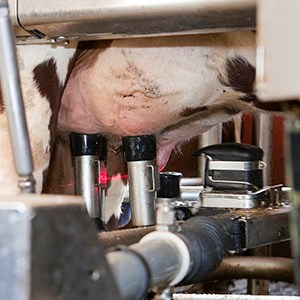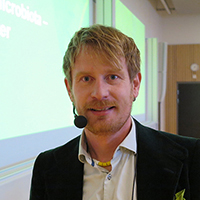Contact
Josef Dahlberg, Doctoral Student, VMD
Department of Animal Nutrition and Management, SLU
josef.dahlberg@slu.se, 018-671686

The overall aim with this thesis was to evaluate the presence of a microbiota in milk coming from healthy lactating cows and describe the factors that affect the milk microbiota.
The idea of a bacterial community, a microbiota, in milk with the purpose of inoculating the offspring's intestine for a better start in life is very appealing from an evolutionary perspective. The overall purpose of this thesis was to investigate if such bacterial community exists in bovine milk from healthy individuals and to describe factors that affect the microbiota.
Sequencing of the 16S rRNA gene was used for studying the microbiota. This method permits the identification of all bacteria present in a sample. Bacterial culturing according to mastitis diagnostics routines were included for reference and inflammatory status was followed by milk somatic cell count.
Three animal experiments were performed with the aims of describing variations in the milk microbiota due to milk sampling technique, milk fraction, over time and during Escherichia coli endotoxin induced mastitis. Additionally, the microbiota in milk samples collected directly from the udder quarter were compared to that found on the skin of the teat end and in the teat canal, as well as in udder quarter composite milk collected from the milking machine.
The results showed that udder quarter composite milk cannot be used as a representative sample to study the microbiota in the udder as the composition of the microbiota in these samples differed significantly from the microbiota in milk collected directly from the teat. Moreover, the microbiota found on the teat end and in the teat canal differed significantly from the microbiota in milk. Despite a careful and sterile handling of samples throughout the whole analytical process, contamination of the sequencing data proved to be a major contributor to the microbiota data in two of the included studies. A correlation between bacterial biomass and impact of contamination was found, showing that the problem increased with low concentration of bacteria in a sample. The degree of contamination of the sequencing data prohibited conclusions on the variation of microbiota over time and during Escherichia coli endotoxin induced mastitis.
The overall conclusion is that contamination, from sample processing, had such a substantial effect on the data that the presence of a microbiota in milk from healthy individuals could not be evaluated.
Read the thesis (pdf)

Josef defends his thesis titled Bovine milk microbiota – methods matter, on December 6 at 1.15 in Audhumbla VHC, Uppsala. Opponent is Professor Rodrigo Carvalho Bicalho from Cornell University, New York.
Photo: Johan Karlsson
Josef Dahlberg, Doctoral Student, VMD
Department of Animal Nutrition and Management, SLU
josef.dahlberg@slu.se, 018-671686